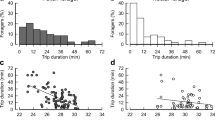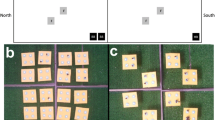Abstract
Eusocial bee foragers leave their nest with nectar as flight fuel, therewith reducing the risk of starvation during a foraging trip. Yet, the extra mass results in an increase of energetic expenditure for flight. Thus, bees should tune their fuel loads to the respective foraging situation. In the present study, we investigated the fuel adjustment in the Brazilian stingless bee Melipona subnitida (Apidae, Meliponini). Specifically, we examined whether foragers of this species increase their fuel loads when they have low expectation for nectar collection during a foraging trip. Crop load measurements revealed that nectar foragers carried significantly less fuel on departing the nest than foragers collecting either pollen, clay, or resin. Surprisingly, 75% of nectar foragers left the nest without any detectable amount of nectar, which suggests that the majority of bees collected at nearby nectar sources and avoided an increase in foraging costs. Moreover, foragers increased their fuel loading when repeatedly experiencing empty food sources that had previously been rewarding. These results support our hypothesis and demonstrate that the capability of fuel adjustment is not restricted to honey bees.





Similar content being viewed by others
References
Atago Co. Ltd. (1987) Atago refractometer data book. Atago Co. Ltd., Tokyo (in Japanese)
Beenakkers AT, Van der Horst D, Van Marrewijk W (1984) Insect flight muscle metabolism. Insect Biochem 14:243–260
Beutler R (1950) Zeit und Raum im Leben der Sammelbiene. Naturwissenschaften 37:102–105
Brandstetter M, Crailsheim K, Heran H (1988) Provisioning of food in the honeybee before foraging. BIONA Rep 6:129–148
Breed MD, Stocker EM, Baumgartner LK, Vargas SA (2002) Time-place learning and the ecology of recruitment in a stingless bee, Trigona amalthea (Hymenoptera, Apidae). Apidologie 33:251–258
Camargo JMF, Pedro SRM (2013) Meliponini Lepeletier, 1836. In Moure, J. S., Urban, D. & Melo, G. A. R. (Orgs). Catalogue of Bees (Hymenoptera, Apoidea) in the Neotropical Region-online version. Available at http://moure.cria.org.br/catalogue. Accessed 29 Jul 2019
Corbet SA, Willmer P (1980) Pollination of the yellow passionfruit: nectar, pollen and carpenter bees. J Agric Sci 95:655–666
Costa CCA, Silva CI, Maia-Silva C, Limão AAC, Imperatriz-Fonseca VL (2017) Origem botânica do mel da jandaíra em áreas de Caatinga nativa do Rio Grande do Norte. In: Imperatriz-Fonseca VL, Koedam D, Hrncir M (eds) A abelha jandaira no passado, no presente e no futuro. EdUFERSA, Mossoró, pp 161–166 (in Portuguese)
Costa-Pereira R (2014) Removal of clay by stingless bees: load size and moisture selection. An Acad Bras Ciênc 86:1287–1293
Edge AA, van Nest BN, Johnson JN, Miller SN, Naeger N, Boyd SD, Moore D (2012) Diel nectar secretion rhythm in squash (Cucurbita pepo) and its relation with pollinator activity. Apidologie 43:1–16
Frisch Kv (1967) The dance language and orientation of bees. Harvard University Press, Cambridge
Gastauer M, Campos LAO, Wittmann D (2011) Handling sticky resins by stingless bees (Hymenoptera, Apidae). Rev Bras Entomol 55:234–240
Gmeinbauer R, Crailsheim K (1993) Glucose utilization during flight of honeybee (Apis mellifera) workers, drones and queens. J Insect Physiol 39:959–967
Harano K, Nakamura J (2016) Nectar loads as fuel for collecting nectar and pollen in honeybees: adjustment by sugar concentration. J Comp Physiol A 202:435–443
Harano K, Sasaki M (2015) Adjustment of honey load by honeybee pollen foragers departing from the hive: the effect of pollen load size. Insect Soc 62:497–505
Harano K, Mitsuhata-Asai A, Konishi T, Suzuki T, Sasaki M (2013) Honeybee foragers adjust crop contents before leaving the hive. Behav Ecol Sociobiol 67:1169–1178
Harano K, Mitsuhata-Asai A, Sasaki M (2014) Honey loading for pollen collection: regulation of crop content in honeybee pollen foragers on leaving hive. Naturwissenschaften 101:595–598
Harano K, Maia-Silva C, Hrncir M (2020) Why do stingless bees (Melipona subnitida) leave their nest with resin loads? Insect Soc. https://doi.org/10.1007/s00040-019-00748-2
Hodges D (1952) The pollen loads of the honeybee: a guide to their identification by colour and form. Bee Research Association, London
Hrncir M, Maia-Silva C, Teixeira-Souza VHS, Imperatriz-Fonseca VL (2019) Stingless bees and their adaptations to extreme environments. J Comp Physiol A 205:415–426
Jesus TNCS, Venturieri GC, Contrera FAL (2014) Time–place learning in the bee Melipona fasciculata (Apidae, Meliponini). Apidologie 45:257–265
Leonhardt SD, Dworschak K, Eltz T, Blüthgen N (2007) Foraging loads of stingless bees and utilisation of stored nectar for pollen harvesting. Apidologie 38:125–135
Maia-Silva C, Hrncir M, Da Silva CI, Imperatriz-Fonseca VL (2015) Survival strategies of stingless bees (Melipona subnitida) in an unpredictable environment, the Brazilian tropical dry forest. Apidologie 46:631–643
Maia-Silva C, Limão AAC, Silva CI, Imperatriz-Fonseca VL, Hrncir M (2019) Stingless bees (Melipona subnitida) overcome severe drought events in the Brazilian tropical dry forest by opting for high-profit food sources. Neotrop Entomol (accepted for publication)
Michener CD (1974) The social behavior of the bees: a comparative study. Harvard University Press, Cambridge
Michener CD (2013) The Meliponini. In: Vit P, Pedro SRM, Roubik D (eds) Pot-honey: a legacy of stingless bees. Springer, New York, pp 3–17. https://doi.org/10.1007/978-1-4614-4960-7_1
Murphy CM, Breed MD (2008) Time-place learning in a neotropical stingless bee, Trigona fulviventris Guérin (Hymenoptera: Apidae). J Kans Entomol Soc 81:73–76
Nachtigall W, Hanauer-Thieser U, Mörz M (1995) Flight of the honey bee VII: metabolic power versus flight speed relation. J Comp Physiol B 165:484–489
Panzenböck U, Crailsheim K (1997) Glycogen in honeybee queens, workers and drones (Apis mellifera carnica Pollm.). J Insect Physiol 43:155–165
Parker RL (1926) The collection and utilization of pollen by the honeybee. Mem Cornell Univ Agric Exp Stat 98:1–55
Pokorny T, Lunau K, Eltz T (2014) Raising the sugar content–Orchid bees overcome the constraints of suction feeding through manipulation of nectar and pollen provisions. PLoS One 9:e113823
Romoser W, Stoffolano J (1994) The science of entomology, 3rd edn. Brown Publishers, Dubuque
Roubik DW (2006) Stingless bee nesting biology. Apidologie 37:124–143
Silva AG, Pinto RS, Contrera FAL, Albuquerque PMC, Rêgo MMC (2014) Foraging distance of Melipona subnitida Ducke (Hymenoptera: Apidae). Sociobiol 61:494–501
Surholt B, Greive H, Hommel C, Bertsch A (1988) Fuel uptake, storage and use in male bumble bees Bombus terrestris L. J Comp Physiol B 158:263–269
Tan K, Latty T, Dong S, Liu X, Wang C, Oldroyd BP (2015) Individual honey bee (Apis cerana) foragers adjust their fuel load to match variability in forage reward. Sci Rep 5:16418
Visscher PK, Seeley TD (1982) Foraging strategy of honeybee colonies in a temperate deciduous forest. Ecol 63:1790–1801
Wenner A (1963) The flight speed of honeybees: a quantitative approach. J Apic Res 2:25–32
Wolf TJ, Schmid-Hempel P, Ellington CP, Stevenson RD (1989) Physiological correlates of foraging efforts in honey-bees: oxygen consumption and nectar load. Funct Ecol 3:417–424
Zanella F (2000) The bees of the Caatinga (Hymenoptera, Apoidea, Apiformes): a species list and comparative notes regarding their distribution. Apidologie 31:579–592
Acknowledgements
We would like to thank two anonymous referees for their valuable comments and suggestions. We also thank Dr. Shinya Hayashi for statistical support. This study was partially supported by a long-term training program of Tamagawa University and a JSPS (Japan Society of the Promotion of Science) Kakenhi Grant Number 17K08154 to KH.
Author information
Authors and Affiliations
Contributions
KH contributed to the study conception and design. CM-S and MH performed material preparation. KH performed data collection and analysis. KH and MH wrote the manuscript. All authors read and approved the final manuscript.
Corresponding author
Ethics declarations
Conflict of interest
The authors declare that they have no conflict of interest.
Additional information
Publisher's Note
Springer Nature remains neutral with regard to jurisdictional claims in published maps and institutional affiliations.
Electronic supplementary material
Fig. S1
Crop volume of Melipona subnitida foragers upon arriving at a feeder. The feeder provides sugar solution during feeding time in feeding period but not in post-feeding period. See text for details. Numbers in parentheses are sample sizes. Error bars indicate standard errors. Different letters on bars indicate significant differences detected by Steel–Dwass test (P < 0.05)
Fig. S2
Concentration of crop content of Melipona subnitida foragers upon arriving at a feeder. The feeder provides sugar solution during feeding time in feeding period but not in post-feeding period. See text for details. Numbers in parentheses are sample sizes. Error bars indicate standard errors. Different letters on bars indicate significant differences detected by Steel–Dwass test (P < 0.05)
Rights and permissions
About this article
Cite this article
Harano, Ki., Maia-Silva, C. & Hrncir, M. Adjustment of fuel loads in stingless bees (Melipona subnitida). J Comp Physiol A 206, 85–94 (2020). https://doi.org/10.1007/s00359-019-01398-2
Received:
Revised:
Accepted:
Published:
Issue Date:
DOI: https://doi.org/10.1007/s00359-019-01398-2




